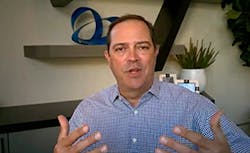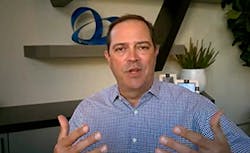Rockwell Automation and Cisco building digital foundations
“Just bringing more of the IT systems onto the industrial network increases the threat surface – exposes more critical infrastructure, critical capabilities to hackers and malevolent people.” Cisco’s Chuck Robbins joined Blake Moret of Rockwell Automation for a virtual fireside chat about the companies’ longstanding partnership.
Any successful partnership begins with an understanding of how to bring value to customers—bringing The Connected Enterprise to life, creating a strong foundation, collecting data and turning it into useful information. “Customers are looking for that as a way to increase their resiliency and agility, particularly now, during these times,” said Blake Moret, chairman and CEO, Rockwell Automation, in a “Fireside Chat” with Chuck Robbins, chairman and CEO, Cisco, this week at the Automation Fair at Home event. “They’re demanding that we work together on digital transformation plans,” Moret continued. “What are you seeing in terms of customer requirements?”
“Everything that made our relationship a good idea 13 years ago has been reinforced and accelerated during the past nine months,” said Robbins. Since March, Rockwell Automation, Cisco and customer companies first did their best to get employees functional from home, then tried to reprioritize and think about their futures.
“As the pandemic has continued to stay with us longer than any of us would have hoped, it really has highlighted business resiliency, and led our customers to think about their priorities and the things they’re focused on,” Robbins said. In many cases, it’s around smarter industrial systems, more connected industrial systems—the integration and bringing together of operational technologies (OT) with classic IT, thinking about security and how they can actually move on some of the transformational projects because they feel like they need to. “The great news is, we have a strong foundation in our partnership, and that allows us to be more effective with our customers,” Robbins added.
“The pandemic has intensified the focus on what’s important,” Moret said, “and we’re seeing a high demand for our ability to offer an integrated, simplified solution that really brings together IT and OT, across the lifecycle of a customer’s investment—from design through operation and management. But we know it’s not just about the technology, it’s about the people, it’s organizational.”
Cisco has seen a real convergence over the past few years. “We’ve seen historically within IT where even small fiefdoms – storage and networking, or the voice and IP networking teams – have come together,” Robbins said. “Sometimes when we’re working with them, we say, that’s not a computer problem, that’s a cultural problem—a cultural challenge.”
It can be complex just getting the dynamics resolved—who owns what, who is responsible for what, the operational governance model moving forward, and the kind of cultural shifts that transpire when a company is going through this kind of transformation. “Those are probably more complicated than the technology we bring to bear,” Robbins said.
Historically, the conversation is about converging IT and OT, “But, it’s really the consolidation of the other technologies, the services, the organizational structure and as you said, the culture,” Moret said.
“Security, for us, is often the first and last question customers ask,” Moret added. IT is trying to create defense in depth across the organization, which is very important as security gives the ability to have the confidence to exchange the data.
“Security is one of the first things we worked on together,” Robbins said. “Just bringing more of the IT systems onto the industrial network increases the threat surface—exposes more critical infrastructure, critical capabilities to hackers and malevolent people. At the same time, a lot of users are remote, and our applications are running on private data centers, using public files, with SaaS applications. The data and traffic flows, the number of people, applications and devices really creates a complex scenario for us to secure.”
The partnership needs to bring resources together to build a holistic solution, the two agreed. “In the future, it’s going to have to be dynamic as we learn in real time what’s going on. For example, an authentication in one part of the plant may not be acceptable in another area,” Robbins said. “A lot of interesting correlations will have to take place.”
Security needs to be a part of a holistic business strategy. “The leadership at our customers is hearing it from their boards, and I’m hearing it from mine,” said Moret. “It’s part of a strategy that considers which partners to bring together, how systems will be implemented, and the ongoing management—making the technology and expertise work together in harmony.”
The editors of Control, Control Design and Smart Industry are providing coverage of Automation Fair At Home, bringing you breaking news, innovations and insights from the virtual event. Once Automation Fair At Home is over, the editors will put together an event report featuring the top news. Pre-order your copy today.
Pre-order the report
About the Author
Paul Studebaker
Paul Studebaker

Leaders relevant to this article:


